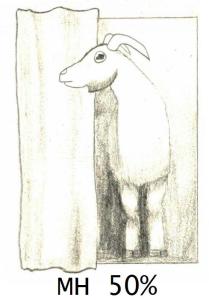Challenge 11 is a Dice by Masashi Tanaka. It’s a very interesting model, with each face marked from 1 to 6.








I used too thick of paper and kind of messed up the #1 face’s square. I didn’t put as much effort into it as some of the other models because, while I like the design, I’m just not that interested in owning the model. It’s a little hard to say. I like having dragons and animals and other things lying around in origami, but I just don’t care to have a dice. Once I figured out the crease pattern for this one, I kind of lost interest in finishing it.
This model does make me think of a couple of other interesting things. A few months back, a friend of mine brought up “The Monty Hall” problem after seeing a TV show it was in. Monty Hall hosted TV game shows in (mainly) the 1960’s and 1970’s. The most famous one he hosted was “Let’s Make a Deal”, in which he would choose a ridiculously dressed audience member, give them something, then try to “make a deal” with them for a mystery prize that may be better or worse than what they started with. Worthless prizes were called “zonks”.
The Monty Hall problem has a player buy one of three curtains or doors, with one having a prize behind it and the other two having zonks. I think the TV show considering this had a car and two goats, so we’ll use those. The problem is: You choose one of the three curtains; Monty Hall reveals one curtain has a goat, and you now have the choice to keep your initial curtain or switch to the remaining one. Do either of these choices have better odds of having a car?
This may be less intuitive than it seems. We’ll label the curtains A, B, and C. Also, for this, we’re going to say the car is behind curtain A. We could pick any curtain to put the car behind; it would only change the labels, not the probabilities.



So, I think this is how it goes. You have your probability of picking any curtain at an even 1/3rd for each door. We’ll represent these as the door labels.
A: You choose door A. P(A) = 1/3
B: You choose door B. P(B) = 1/3
C: You choose door C. P(C) = 1/3
The final probability of your choice between initial and remaining curtains is the product of your choice’s probability and the probability of what Monty Hall does.
X: Monty Hall opens door A.
Y: Monty Hall opens door B.
Z: Monty Hall opens door C.
Each of his probabilities is conditional: what does he do given your choice of door? Conditional probabilities are shown as P(scenario|event), probability of a scenario given an event. Since the car is behind door A, the probability of Monty Hall opening curtain A, scenario X, is always 0, regardless of your choice (P(X|any choice)=0). This gives us two options if we’ve chosen correctly and one for each wrong guess:
If we’ve chosen door A, Monty Hall might open either door with equal probability:
P(Y|A)=1/2; P(Z|A)=1/2



If we’ve chosen wrong, Monty Hall will always open the other wrong door:
P(Z|B)=1



P(Y|C)=1



The final probabilities are the products of your and Monty Hall’s choices:
The probability that you’ve chosen correctly gives one of two scenarios:
P(A)P(Y|A)=(1/3)(1/2)=1/6
P(A)P(Z|A)=(1/3)(1/2)=1/6
Therefore, the probability that your initial guess is correct is the sum of these (i.e. you’ve hit one of these two scenarios):
P(initially correct) = (1/6)+(1/6) = 1/3.
The probability of the incorrect scenarios and total probability of the initial guess being wrong is:
P(B)P(Z|B)=(1/3)(1)=1/3
P(C)P(Y|C)=(1/3)(1)=1/3
P(initially incorrect) = (1/3)+(1/3) = 2/3
So, if you switch from your initial guess, you actually have a 2/3rds chance of getting a car, as opposed to a 1/3rd chance if you stick with it.
Of course, there is a more intuitive way of thinking of this problem (I just kind of wanted to draw a goat). That’s that your initial guess has only 1/3rd chance of being right and 2/3rds chance to be wrong. When one of the three is eliminated, there is 100% chance the eliminated door is a wrong door. If you had a larger chance of initially being wrong, switching can only improve your odds.
The other thing I thought of has more to do with the crease pattern. This origami dice is not weighted evenly, so I started wondering about probabilities in weighted dice. Online, most info is about distribution functions for sums of a loaded dice and an evenly weighted one, but I was wondering just about the probabilities for each side. They used an assumed probability of the side opposing the weight being increased with all the other sides being the same (say the increased face occurs 1 in 2, while the others all have a 1 in 10 chance). But would that really be true? The four faces on the sides should all have the same chance, but what about the opposing side, with the weight?

Would the weight with the momentum cause it to topple to one of the sides more often, or would the increased weight moving from an unweighted side to the weighted end cancel the force, causing the opposing face to also be more likely than the sides? How much does the direction of force matter? Would all these factors cancel, giving the other 5 faces all the same probability? I figure I’d have to get a weighted dice and throw it 1000 or so times to actually figure this out, but I’m probably not going to do that. Neat to think about though.















































